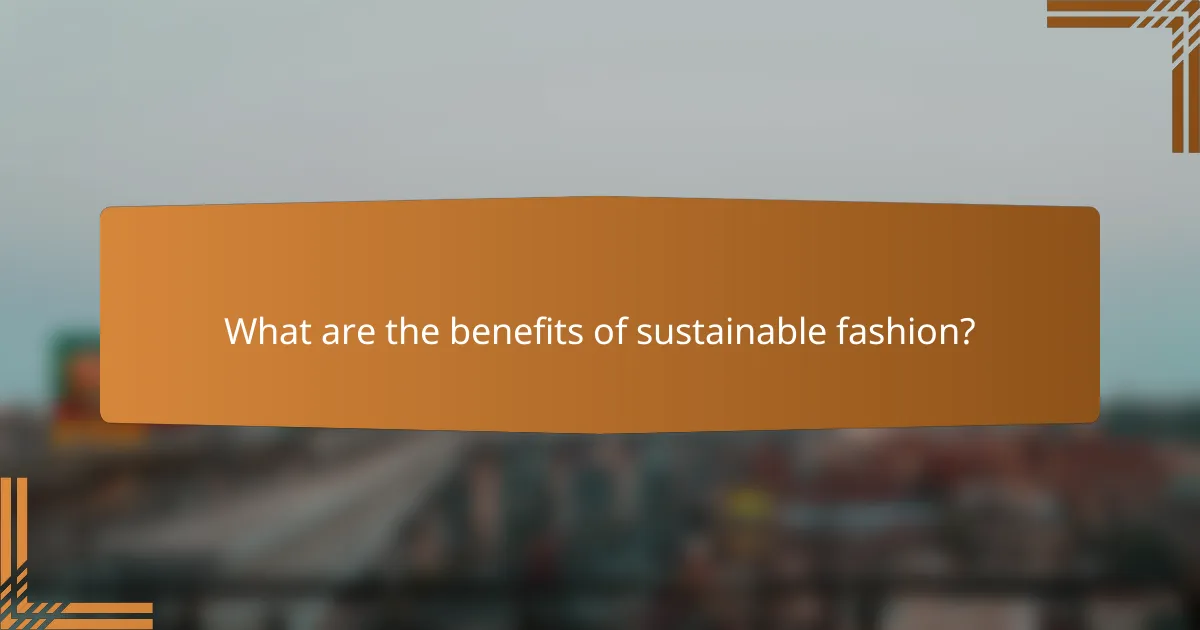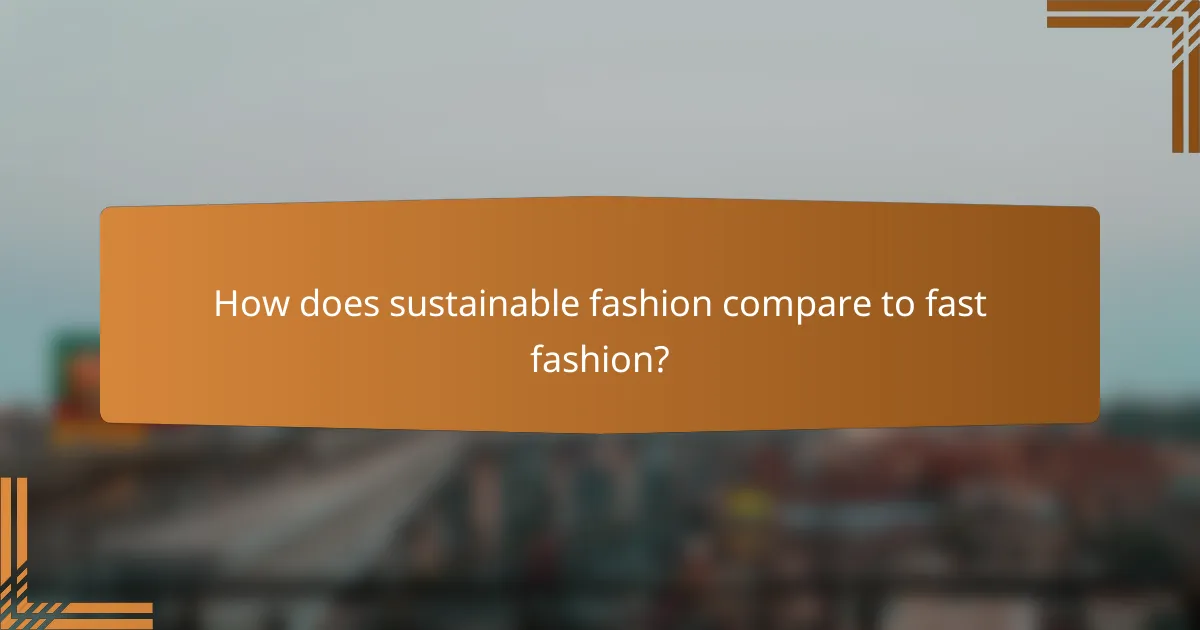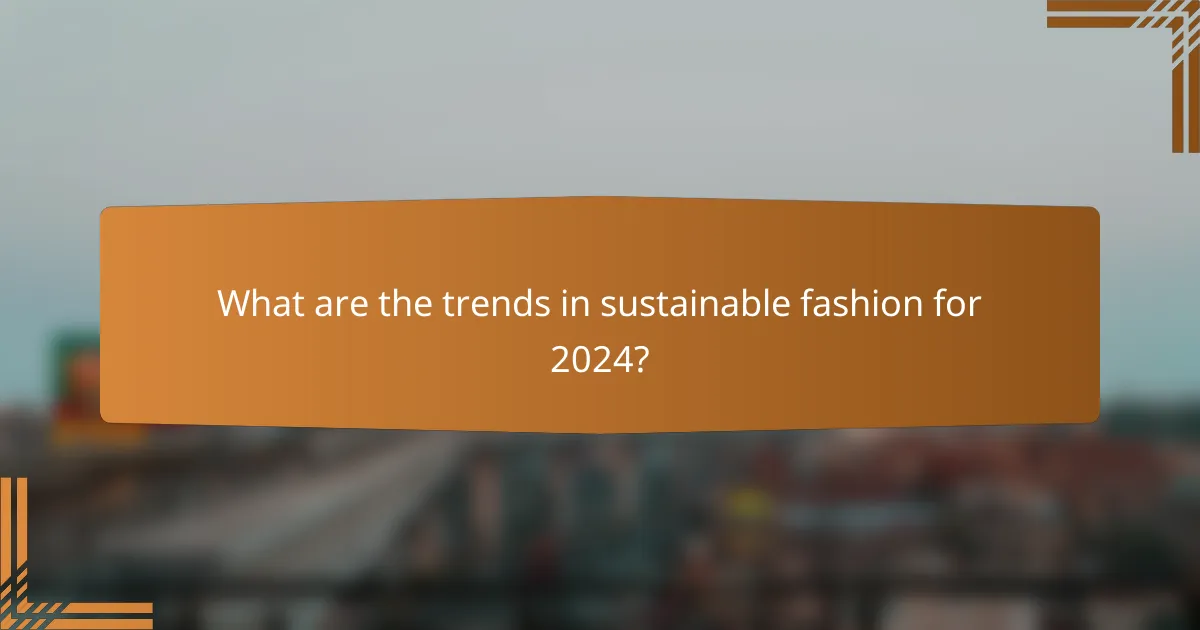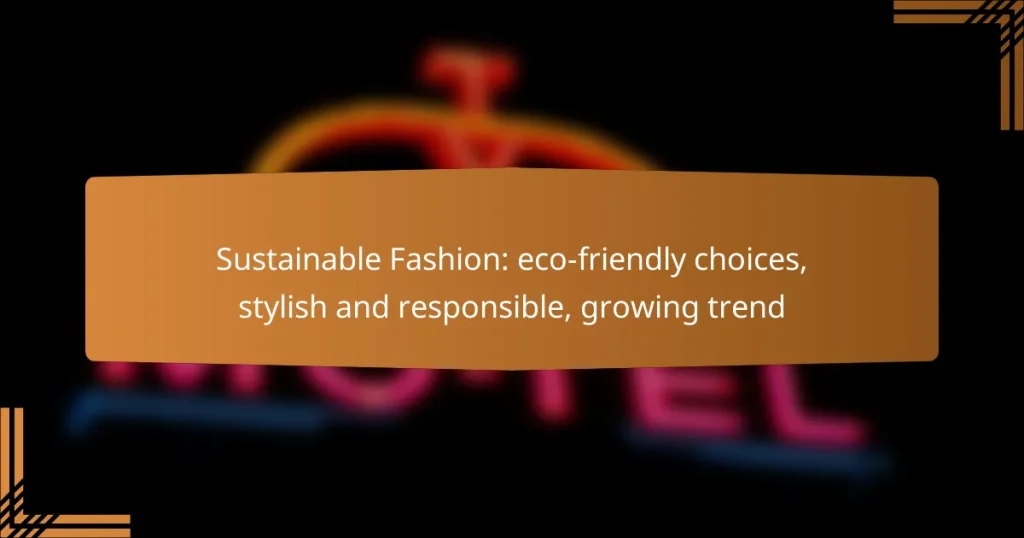Sustainable fashion is an emerging trend that emphasizes eco-friendly choices and ethical production practices, allowing consumers to make stylish yet responsible wardrobe selections. By prioritizing materials and labor practices that are kind to the environment and society, sustainable fashion not only reduces our ecological footprint but also supports a more equitable industry. As awareness grows, more individuals are embracing this movement, seeking to align their fashion choices with their values.

How can I choose sustainable fashion brands in the UK?
To choose sustainable fashion brands in the UK, look for companies that prioritize eco-friendly materials, ethical labor practices, and transparent supply chains. These factors ensure that your clothing choices contribute positively to the environment and society.
Brands with eco-friendly materials
When selecting sustainable fashion brands, focus on those that use organic, recycled, or biodegradable materials. Look for certifications like GOTS (Global Organic Textile Standard) or OEKO-TEX, which indicate environmentally friendly practices.
Examples of eco-friendly materials include organic cotton, Tencel, hemp, and recycled polyester. Brands like People Tree and Reformation are known for their commitment to using such materials in their collections.
Brands with ethical labor practices
Ethical labor practices are crucial in sustainable fashion. Choose brands that ensure fair wages, safe working conditions, and no child labor. Certifications like Fair Trade can help identify brands that adhere to these standards.
Brands such as Everlane and Thought Clothing are recognized for their transparency regarding labor practices. They often provide information about their factories and the conditions workers face, allowing consumers to make informed choices.
Brands with transparent supply chains
Transparency in the supply chain allows consumers to understand where and how their clothes are made. Look for brands that openly share information about their sourcing, production processes, and environmental impact.
Many sustainable brands, like Patagonia and Veja, publish detailed reports on their supply chain practices. This transparency helps build trust and ensures that your purchases support responsible production methods.

What are the benefits of sustainable fashion?
Sustainable fashion offers numerous advantages, including a reduced environmental footprint, support for ethical labor practices, and enhanced product longevity. These benefits contribute to a more responsible and stylish wardrobe that aligns with eco-conscious values.
Reduced environmental impact
Sustainable fashion significantly lowers the environmental impact associated with clothing production. By using organic materials, minimizing waste, and employing eco-friendly manufacturing processes, brands can help reduce pollution and conserve resources.
For instance, opting for garments made from organic cotton or recycled materials can cut down on water usage and chemical runoff. Consumers can also look for certifications like GOTS (Global Organic Textile Standard) to ensure their choices are truly sustainable.
Support for ethical labor
Choosing sustainable fashion often means supporting brands that prioritize ethical labor practices. Many sustainable brands ensure fair wages, safe working conditions, and respect for workers’ rights, which contrasts sharply with fast fashion’s exploitative practices.
When shopping, look for transparency in a brand’s supply chain. Certifications such as Fair Trade can help identify companies committed to ethical labor standards, ensuring that your purchases contribute positively to the lives of workers.
Long-lasting quality
Sustainable fashion emphasizes quality over quantity, resulting in garments that are designed to last. Investing in well-made clothing reduces the need for frequent replacements, ultimately saving money and resources.
To identify high-quality sustainable pieces, check for durable materials, thoughtful craftsmanship, and timeless designs. Avoid trends that may quickly go out of style, and instead, focus on versatile items that can be worn across seasons.

How does sustainable fashion compare to fast fashion?
Sustainable fashion focuses on eco-friendly practices and ethical production, while fast fashion prioritizes rapid production and low costs, often at the expense of the environment and labor conditions. The key difference lies in the long-term impact on the planet and society versus immediate consumer gratification.
Environmental footprint comparison
Sustainable fashion typically has a much lower environmental footprint than fast fashion. This is due to the use of organic materials, reduced water consumption, and minimized waste during production. Fast fashion, on the other hand, often relies on synthetic materials and mass production, leading to significant pollution and resource depletion.
For example, producing a single cotton t-shirt can require thousands of liters of water, while sustainable brands often implement practices that reduce water use by up to 90%. Additionally, sustainable brands may use recycled materials, further decreasing their ecological impact.
Cost analysis over time
While sustainable fashion items may have a higher upfront cost, they often prove to be more economical in the long run. Higher-quality materials and craftsmanship lead to longer-lasting products, reducing the need for frequent replacements. In contrast, fast fashion items are usually cheaper but wear out quickly, resulting in higher cumulative spending over time.
Consumers can save money by investing in a few versatile, high-quality pieces rather than continuously buying low-cost items that need to be replaced. A sustainable wardrobe may initially require a larger investment, but it can lead to significant savings and less waste over the years.
Quality and durability differences
Sustainable fashion is generally characterized by superior quality and durability compared to fast fashion. Brands committed to sustainability often prioritize craftsmanship and use higher-quality materials, resulting in products that withstand wear and tear. Fast fashion, however, focuses on rapid production and low costs, leading to lower-quality items that may not last beyond a few washes.
For instance, a sustainably made jacket may last several years with proper care, while a fast fashion equivalent might only last a season. Investing in sustainable fashion not only supports ethical practices but also ensures that consumers receive products that are built to last.

What are the key materials used in sustainable fashion?
Sustainable fashion primarily utilizes eco-friendly materials that minimize environmental impact while maintaining style and functionality. Key materials include organic cotton, recycled polyester, and innovative fabrics like Tencel, each offering unique benefits for both consumers and the planet.
Organic cotton
Organic cotton is grown without synthetic pesticides or fertilizers, making it a healthier choice for the environment and farmers. This method of cultivation also conserves water and promotes biodiversity, often resulting in a softer fabric.
When choosing organic cotton, look for certifications such as GOTS (Global Organic Textile Standard) to ensure quality and sustainability. Brands that prioritize organic cotton often highlight it in their marketing, making it easier for consumers to make informed choices.
Recycled polyester
Recycled polyester is made from post-consumer plastic waste, such as bottles, reducing the need for virgin materials and lowering carbon emissions. This material is durable, lightweight, and can be recycled again, contributing to a circular economy.
When purchasing items made from recycled polyester, check for certifications like the Global Recycled Standard (GRS) to ensure the product meets environmental and social criteria. Many brands now offer stylish options made from this sustainable fabric, appealing to eco-conscious consumers.
Tencel and other sustainable fabrics
Tencel, made from sustainably sourced wood pulp, is known for its softness and breathability. It is produced in a closed-loop process that recycles water and solvents, minimizing waste and environmental impact.
Other sustainable fabrics include hemp and linen, which require fewer resources to grow and process. When selecting garments made from these materials, consider their durability and care requirements to maximize their lifespan and reduce waste.

How can I incorporate sustainable fashion into my wardrobe?
Incorporating sustainable fashion into your wardrobe involves selecting eco-friendly materials, supporting ethical brands, and making mindful choices about your clothing. By focusing on quality, versatility, and a mix of vintage and new pieces, you can build a stylish and responsible collection that reflects your values.
Mixing vintage and new sustainable pieces
Combining vintage clothing with new sustainable items can create a unique and stylish wardrobe. Vintage pieces often have a lower environmental impact since they are pre-owned, while new sustainable items are made from eco-friendly materials and ethical practices.
When shopping for vintage, consider local thrift stores or online platforms that specialize in second-hand fashion. Look for timeless styles that can easily blend with your new sustainable pieces, ensuring versatility and longevity in your outfits.
Choosing versatile styles
Selecting versatile styles is key to maximizing the sustainability of your wardrobe. Look for clothing that can be dressed up or down, allowing for multiple occasions with fewer items. Basics like a well-fitted pair of jeans, a classic white shirt, or a little black dress can serve as the foundation for various outfits.
Consider neutral colors and simple designs that can be easily mixed and matched. This approach not only reduces the need for excessive purchases but also simplifies your daily outfit choices.
Prioritizing quality over quantity
Focusing on quality rather than quantity is essential in sustainable fashion. Invest in well-made pieces that are durable and timeless, which will last longer and reduce the frequency of replacements. Look for brands that emphasize craftsmanship and use sustainable materials.
A good rule of thumb is to ask yourself if you would wear an item at least 30 times before purchasing. This mindset helps ensure that each piece in your wardrobe is a thoughtful addition rather than a fleeting trend.

What are the trends in sustainable fashion for 2024?
In 2024, sustainable fashion trends focus on eco-friendly materials, ethical production practices, and circular economy principles. Consumers increasingly seek stylish options that minimize environmental impact while supporting responsible brands.
Eco-friendly materials
Eco-friendly materials are at the forefront of sustainable fashion, with brands opting for organic cotton, Tencel, and recycled fabrics. These materials reduce reliance on harmful pesticides and synthetic fibers, contributing to a lower carbon footprint.
For instance, organic cotton uses natural farming methods, which can decrease water usage by up to 90% compared to conventional cotton. Additionally, recycled polyester, made from plastic bottles, helps divert waste from landfills while creating fashionable garments.
Ethical production practices
Ethical production practices emphasize fair labor conditions and transparency in the supply chain. Brands are increasingly adopting certifications like Fair Trade and B Corp, ensuring that workers receive fair wages and safe working environments.
Consumers can support ethical fashion by researching brands and looking for those that disclose their sourcing and labor practices. This not only promotes social responsibility but also encourages more companies to adopt similar standards.
Circular economy principles
Circular economy principles aim to extend the lifecycle of clothing through recycling, upcycling, and resale. This trend encourages consumers to buy second-hand items or participate in clothing swaps, reducing waste and promoting sustainability.
Brands are also implementing take-back programs, allowing customers to return used items for recycling or refurbishment. This approach not only minimizes landfill waste but also fosters a culture of responsible consumption.


